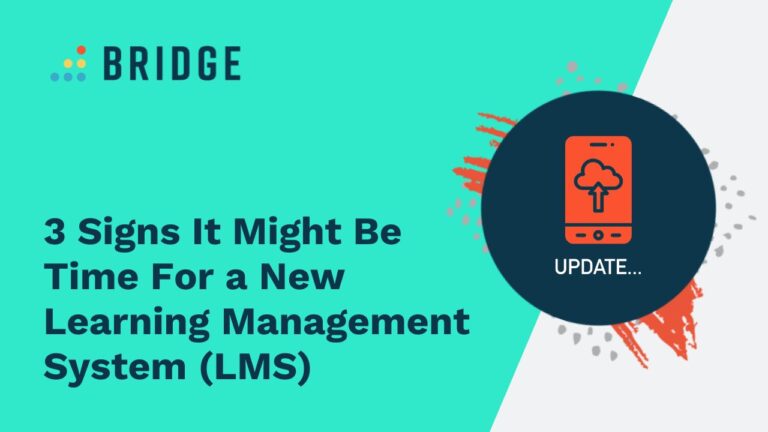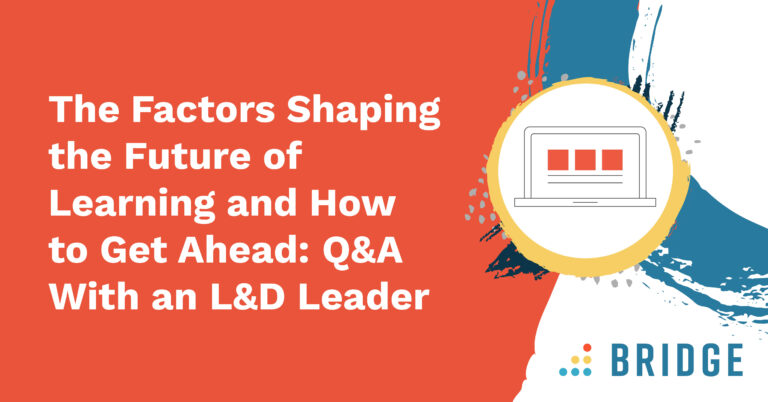Learning management system (LMS) migration is a big investment—but if you can’t recognize when you need to make that investment, or if you put it off for too long, you’ll find yourself wishing you’d struck while the iron was hot. So, how do you know when it’s hot enough?
Let’s say you’re a growing financial services organization, and you need to scale your ability to supply compliance training to an expanding workforce. Alternatively, you might be a nonprofit looking to deliver external training to your large volunteer base. In these scenarios, a feature-light learning system won’t be able to effectively keep up with your demands—and it’s time to make the switch.
On the other hand, you might be a mid-market enterprise that has a basic learning system built into the broader structure of your HRIS, and you’re starting to notice that you need a more versatile solution.
In either case, you’ll find yourself in a scenario that warrants a new LMS. So, let’s take a closer look at the situations that demand an LMS upgrade—along with the features and capabilities you’ll want your new solution to offer.
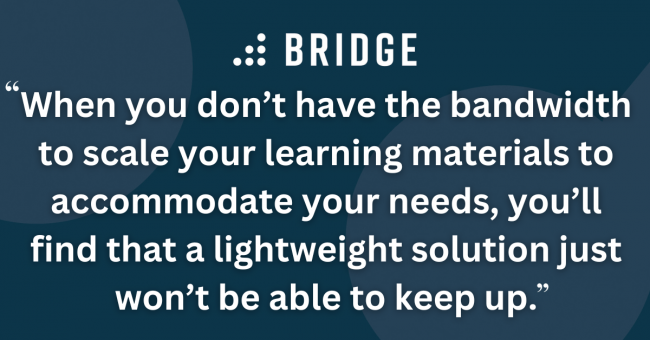
Scenario 1) Your Organization is Growing Beyond Lightweight Tools and Static Spreadsheets
Among smaller organizations, it’s not uncommon to start out with an inexpensive, feature-light LMS (or even a spreadsheet) that’s primarily designed to handle basic compliance requirements. That’s fine when your organization is in its infancy—but as your workforce grows, you might find yourself starting to feel the lack of a more well-rounded selection of LMS features.
As your organization scales, you’ll encounter new learning-related challenges. For example:
- Employee onboarding will start to happen at a more frequent cadence
- You’ll need better information on your expanded workforce’s development efforts
- You’ll likely lack the bandwidth to scale your learning materials to accommodate your needs
In these common situations, you’ll find that a lightweight solution or static document just won’t be able to keep up. So, what features might a new LMS bring to the table in support of your growth? Let’s take a look.
New Hire Onboarding Is Becoming More Frequent (Especially With Seasonal Workers and in High Turnover Businesses)
When taking on a new hire is a rare event, you might be able to skate by on manual onboarding processes supported by basic tools or spreadsheets. But as employees start to come and go more often, you won’t be able to onboard new recruits with the same level of care and attention—and you might find yourself wishing that your feature-light solution or your static documents could lighten your administrative load.
After all, there’s no question that a good onboarding experience can have a range of handy knock-on effects. According to the UK’s Chartered Institute of Personnel and Development, a strong induction can impact things like:
- Employee turnover
- Absenteeism
- Employer brand
In short: it’s worth getting right, and an LMS upgrade can help you unlock all these benefits. A more sophisticated LMS will give you the power to upgrade your onboarding process via automated learning pathways that deliver the right onboarding materials at sensible and consistent intervals. This ensures your new hires get the comprehensive induction they need without getting buried under an avalanche of material.
Bridge Journeys (our own take on course chunking) also allows you to add variety to your onboarding pathways with steps including checkpoints, live experiences, and key actions—while ensuring that every new employee encounters content that ranges from learning courses to video training and more. You won’t get that from a spreadsheet!
In-Depth Analytics Are Necessary to Report on Compliance and Other Training Programs
As your organization scales, so will your need for in-depth reporting and analytics on learning programs. You’ll need detailed insights across various metrics that a simple spreadsheet just can’t track.
This is something you’ll particularly start to notice as you build out a more well-rounded L&D function. The more learning opportunities and skills development materials you offer your people, the more you’ll benefit from a platform that allows you to track metrics like employee usage and course completion rates.
With a solution like Bridge, you’ll also benefit from custom reports that can be filtered by categories like learner type, due dates, and similar fields—giving you pinpoint insights on key sections of your growing workforce in ways that static documents can’t match.
RELATED READING | ‘Learning Analytics: 4 Essential Metrics and Strategies for L&D Success’
You Need Easy Course Authoring With No Design or Development Expertise Needed
You might want to track and measure your learning materials—but first, you’ll need to create them!
This is another task that requires an increasing amount of bandwidth as your organization grows. Different teams and departments will need different kinds of training, which is likely to go way beyond the capabilities of a feature-light LMS designed to handle basic compliance activities—not to mention a manual spreadsheet. Plus, an expanded workforce doesn’t equate to a full-fledged L&D function: you won’t have the tech or the people to start producing high volumes of quality content at the snap of your fingers.
This is another situation in which a feature-rich LMS can really shine. A good LMS like Bridge will come equipped with a native authoring tool that allows anyone at all to generate simple learning materials. This means you can supplement your current L&D function with your organization’s subject matter experts, who can quickly produce handy content at the push (more or less!) of a button.
That’s not to say that your subject matter experts are limited to creating basic content. With Bridge, you can choose to incorporate Gomo’s advanced content authoring tool as an add-on. Gomo’s drag-and-drop simplicity makes it perfect for non-L&D specialist users, while its powerful features and direct publishing capabilities ensure that you can supply your growing list of learners with top-quality content at scale.
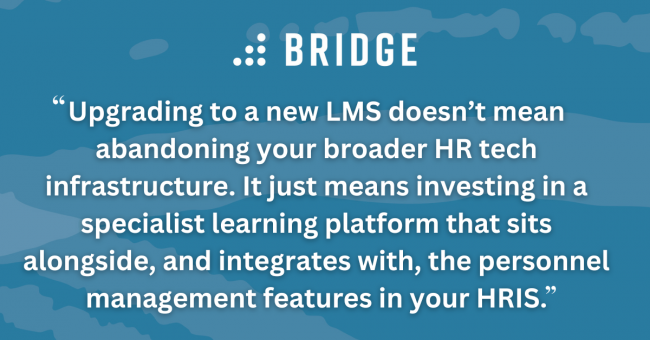
Scenario 2) You Need the Support of a Specialized Vendor
You don’t have to be a smaller organization to feel the benefits of an LMS upgrade.
We sometimes encounter mid-market organizations that conduct their L&D efforts using the built-in learning tools within their larger HR infrastructure. While this is fine for ticking the occasional compliance box, these organizations can also find themselves lacking key learning capabilities.
Upgrading to a new LMS doesn’t mean abandoning your broader HR tech infrastructure. It just means investing in a specialist learning platform that sits alongside, and integrates with, the personnel management features in your HRIS.
Not only does this LMS integration practice ensure that you get all the onboarding, authoring, and analytics features we’ve already discussed—but you also get the support that comes hand in hand with an attentive provider.
Seamless Support From Integration to Consolidation
While there’s a lot to be said for the larger HR tech platforms, a small-to-medium enterprise comprising a few hundred employees is inevitably going to have less of a presence on the radar of a provider that’s catering to organizations that have tens of thousands of employees.
The right specialist vendor will offer the LMS training and support your organization’s needs. That’s a principle we take seriously at Bridge: our customers enjoy 24/7/365 technical support, open office hours, live group training, and a host of supplementary services to ensure that everyone is getting the most out of the platform.
Crucially, this process still allows you to consolidate your HR tech. You can integrate Bridge’s learning solution (and its performance management system) into your HRIS, ensuring that your HR tech stack is a single, seamless ecosystem that provides the perfect tools for every use case, whether you’re organizing payroll in your HRIS or tracking course completion rates in your specialist LMS.
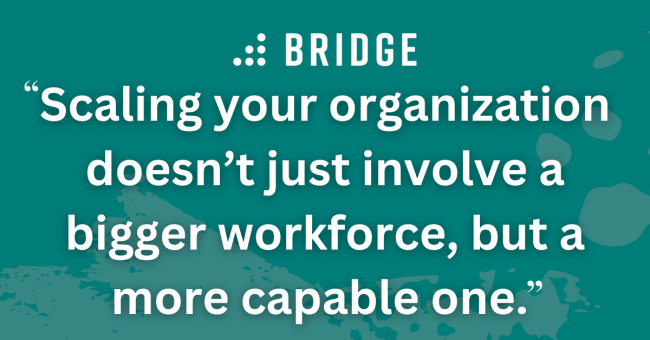
MORE FROM THE BLOG | ‘5 Benefits of Integrating Your LMS With Your HRIS’
Scenario 3) You Need to Offer Learning and Development Opportunities That Go Beyond Compliance
Whether you’re a smaller organization looking to upgrade from a static document system or you’re a larger enterprise looking for support and functionality to better complement your HRIS, it’s likely that you’ll want more than a tool that handles compliance and onboards employees. Forward-thinking, growth-first organizations also need to foster employee development.
This is an investment well worth making. Employees who feel they have the right development opportunities at their disposal are likely to encounter a wealth of benefits. A 2023 survey from Deloitte found that over a third of employees want “ample opportunities to learn new things and develop skills”—an ambition that a more sophisticated learning tool can absolutely address.
So, how can a new LMS help turn your people into dynamos of continuous learning? The key feature to look out for is upskilling—especially with a little AI-powered assistance.
Targeted Upskilling With AI-Powered Skills Recommendations
Scaling your organization doesn’t just involve a bigger workforce, but a more capable one. Your people need to grow alongside your organization, which means they need to be supplied with relevant development opportunities that match individual ambitions and organizational needs.
Your lightweight legacy LMS won’t be able to cater to this more sophisticated demand, but a dedicated platform like Bridge will have no trouble ensuring that the right people get the right training. Our AI-powered upskilling platform, Skills Plus, draws from a huge database of up-to-date skills requirements for specific job titles and recommends learning content that’s been automatically tagged with those skills—making it easy to fill skills gaps and keep your people developing in all the ways that matter.
MORE FROM THE BLOG | ‘Want to Address Your Skills Gaps? Here’s How AI-Assisted Skills Assessments Can Help’
Make the Switch Simple With Bridge
Migrating to a new learning system can be a slightly intimidating prospect, but Bridge ensures that the process is seamless—and speedy, too!
We provide an implementation specialist who will help you set up our LMS, Bridge Learn, within a period of weeks. We also offer expertise on LMS change management and rollout strategies, on top of that all-important technical support. With regular open office hours available for all our customers, you’ll be overflowing with opportunities to get your new LMS up and running.
So, while switching to an LMS will always involve a little resistance, Bridge specialists will ensure that you experience a smooth transition. With our help, it’ll be easy to enjoy the many and varied onboarding, development, and analytics capabilities that’ll define your new learning ecosystem and justify your investment to your stakeholders.
BUILD A BUSINESS CASE | ‘Pitch (And Implement) Your Training Budget With These 4 Simple Steps’
Upgrade Your LMS to Bridge
Bridge’s LMS offers everything you need to supercharge your upskilling strategy, scale your content output, and automate key processes like onboarding. Request a demo or get a free trial to find out what you’re missing.
